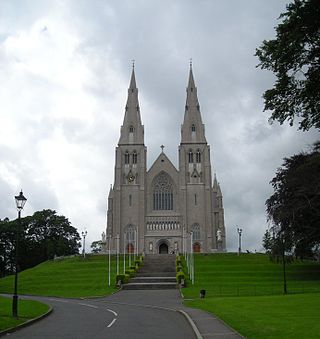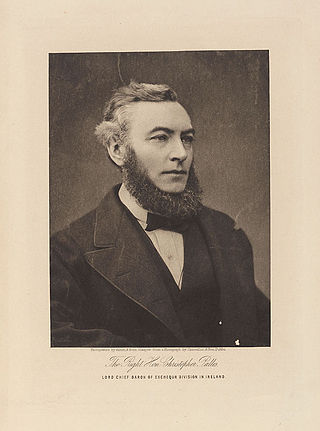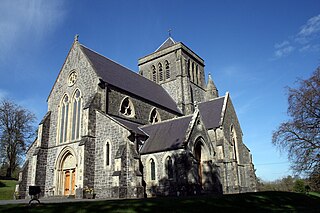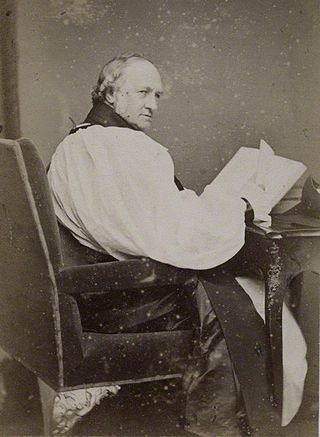Biography
Spinellis was born in Italy, probably in Lombardy. [1] He is said to have been attached to the Curia, and his residence in the Apostolic Palace in the Vatican City may have given rise to his alternative surname De Palatio (later Anglicised to Palles). [1]
He was sent to Ireland as Papal Nuncio in 1477 to investigate the disastrous financial condition of the See of Armagh. The then Archbishop, Edmund Connesburgh, was not personally responsible for the enormous debts of the Archdiocese, which had been incurred by his predecessor John Bole, who died in 1471, but he had been unable to remedy the situation. Despite having been the personal choice of King Edward IV for Archbishop, Connesburgh was persuaded to resign in return for a pension and the cancellation of his debts. In the circumstances, the choice of Spinellis, whom the Pope had always preferred to Connesburgh, to replace him, was an obvious one. The new archbishop disliked Ulster and preferred to live in Dublin or the counties of The Pale adjoining it. [1]
As Archbishop, he had to adjudicate in a dispute within the Diocese of Kilmore. When he held his first Provincial Council at Drogheda in July 1480, [2] an objection was raised to the appointment of Cormac Mág Shamhradháin because he was illegitimate. This appointment was revoked on 20 October 1480 and Tomás Mac Brádaigh, the Archdeacon of Kilmore, recommended to replace him: his decision was confirmed by Pope Sixtus IV. [3]
Later in the decade, the Archbishop clashed bitterly with the Bishop of Meath, John Payne. [4] Payne had been deeply involved in the attempt to put the pretender Lambert Simnel on the English throne, and had preached the sermon at Simnel's so-called coronation in Dublin. [4] Simnel's cause was crushed at the Battle of Stoke Field in June 1487. Payne, like nearly all of Simnel's supporters, received a royal pardon from the victorious Henry VII, but apparently felt that he could improve his standing at Court by attacking Spinellis, with whom his relations were never good. [4] His claims that Spinellis was sympathetic to Simnel's cause were not taken seriously: as a foreigner whose residence in the British Isles was a matter of chance, there was no reason for Spinellis to involve himself in English dynastic struggles. Nonetheless, after the failure of Simnel's case, as a precaution, he was required to swear the usual oath of fealty to the new regime. [4]
Simnel's cause ruined another turbulent Irish cleric with whom Spinellis had quarrelled, James Keating, Prior of the Irish House of the Knights Hospitallers at Kilmainham. Keating had been removed by the mother House as Prior and replaced by Marmaduke Lumley: but he refused to vacate his office, and threw Lumley into prison, where he died. [5] Spinellis and his fellow Archbishop, John Walton of Dublin, made vigorous efforts to free him, even hiring troops, but to no effect. No doubt Spinellis was among those who opposed pardoning Keating for his active role in the Simnel Rebellion. Keating was expelled from the Order House at Kilmainham and died in poverty a few years later. [6]
Spinellis died in office in 1513. He was described as "a man of considerable wisdom and learning". [1] Several of his relatives had accompanied him to Ireland, and settled there. [1] They used the alternative surname De Palatio, which was Anglicised to Palles, and became prosperous landowners in County Cavan. They remained loyal to the Roman Catholic faith, even at the height of the Penal Laws. [1] The most distinguished of the family was Christopher Palles (1831-1920), Chief Baron of the Irish Exchequer, who is still often called "the greatest of the Irish judges". [1]
The Primacy of Ireland refers to the office of the highest Catholic authority in the island of Ireland. Primate is a title of honour denoting ceremonial precedence in the Church, and in the Middle Ages there was an intense rivalry between the Archbishop of Armagh and the Archbishop of Dublin as to seniority. The dispute between the two archbishoprics was finally settled by Pope Innocent VI. Since 1353 the Archbishop of Armagh has been titled Primate of All Ireland and the Archbishop of Dublin Primate of Ireland, signifying that they are the senior churchmen on the island of Ireland, the Primate of All Ireland being the more senior. The titles are used by both the Catholic and Church of Ireland bishops. The distinction mirrors that in the Church of England between the Primate of All England, the Archbishop of Canterbury, and the Primate of England, the Archbishop of York.
The Lord High Chancellor of Ireland was the highest judicial office in Ireland until the establishment of the Irish Free State in 1922. From 1721 to 1801, it was also the highest political office of the Irish Parliament: the Chancellor was Speaker of the Irish House of Lords. The Lord Chancellor was also Lord Keeper of the Great Seal of Ireland. In all three respects, the office mirrored the Lord High Chancellor of Great Britain.

Raffaele Sansoni Galeoti Riario was an Italian Cardinal of the Renaissance, mainly known as the constructor of the Palazzo della Cancelleria and the person who invited Michelangelo to Rome. He was a patron of the arts. He was also the first adolescent to be elevated in the College of Cardinals in the history of the Holy See.

The Archdiocese of Armagh is a Latin ecclesiastical territory or archdiocese of the Catholic Church located in the northern part of Ireland. The ordinary is the Roman Catholic Archbishop of Armagh who is also the Metropolitan of the Ecclesiastical province of Armagh and the Primate of All Ireland. The mother church is St Patrick's Cathedral. The claim of the archdiocese to pre-eminence in Ireland as the primatial see rests upon its traditional establishment by Saint Patrick circa 445. It was recognised as a metropolitan province in 1152 by the Synod of Kells.

Christopher Palles was an Irish barrister, Solicitor-General, Attorney-General and a judge for over 40 years. His biographer, Vincent Thomas Hyginus Delany, described him as "the greatest of the Irish judges". He served as the last Lord Chief Baron of the Exchequer from 1874 until his retirement from the bench in 1916.

The Bishop of Kilmore is an episcopal title which takes its name after the parish of Kilmore, County Cavan in Ireland. In the Roman Catholic Church it remains a separate title, but in the Church of Ireland it has been united with other bishoprics.

Marcus Gervais Beresford was the Church of Ireland Bishop of Kilmore, Elphin and Ardagh from 1854 to 1862 and Archbishop of Armagh and Primate of All Ireland from 1862 until his death.
Thomas Lancaster was an English Protestant clergyman, Church of Ireland Archbishop of Armagh from 1568.
Sir Robert Dowdall was an Irish judge who held the office of Chief Justice of the Irish Common Pleas for more than forty years. He is mainly remembered today for the murderous assault on him by Sir James Keating, the Prior of Kilmainham, in 1462.
Cormac Mác Shamhradháin O.S.A., b. c.1410-d.1476, was the Roman Catholic Bishop of Ardagh diocese in Ireland from 1444 to 1476.
Cormac Mág Shamhradháin O.S.A., b. c.1442-d.1511, was the Roman Catholic Bishop of Kilmore diocese, Ireland from 1476 to 1480 and the anti-bishop of Kilmore from 1480 to 1511.
John Payne, Bishop of Meath, held that office from 1483 until his death in 1506; he was also Master of the Rolls in Ireland. He is best remembered for his part in the coronation of Lambert Simnel, the pretender to the Crown of England, in 1487.

Ernest II of Saxony held two episcopal titles: Archbishop of Magdeburg ; Administrator of the Diocese of Halberstadt.
Georg Hesler (1427–1482) was a German Roman Catholic cardinal and bishop.
Cosma Orsini was an Italian Roman Catholic bishop and cardinal.
John Walton was an English canon regular who became Archbishop of Dublin.
Sir Thomas Plunket (c.1440–1519) was a wealthy Irish landowner, lawyer and judge in fifteenth-century and early sixteenth-century Ireland. He held office as Chief Baron of the Irish Exchequer and Chief Justice of the Irish Common Pleas. After the change of the English royal family in 1485, his loyalty to the new Tudor dynasty was deeply suspect, and he was involved in two attempts to put a pretender on the English throne. On each occasion he was disgraced, fined and removed from office; yet he had sufficient political influence to ensure his return to favour and high office.
Sir James Keating was an Irish cleric and statesman of the fifteenth century. He was Prior of the Irish house of the Knights Hospitallers, which was based at Kilmainham, Dublin, and a member of the Privy Council of Ireland.
Tomás Mac Brádaigh O.S.A., b. was the Roman Catholic Bishop of Kilmore diocese, Ireland from 1480 to 1511.
Walter Champfleur or de Champfleur was an Irish cleric and judge of the fifteenth century, who played a leading role in Irish politics.
This page is based on this
Wikipedia article Text is available under the
CC BY-SA 4.0 license; additional terms may apply.
Images, videos and audio are available under their respective licenses.





